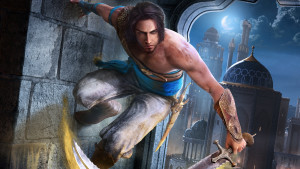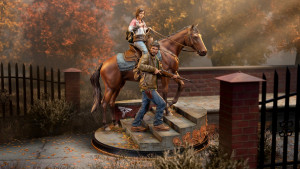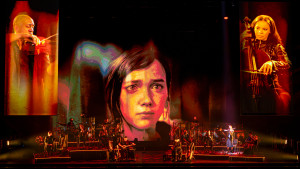The magazine is back. Get your subscription now!
Five Open-World Game Essentials

Open-world games are here to stay. This new generation has already embraced this genre with titles Watch Dogs, Infamous: Second Son, and Middle-earth: Shadow of Mordor. Even more of these games are coming; Sunset Overdrive launches today, while Assassin's Creed Unity, The Witcher 3: Wild Hunt, and Dying Light accompany a slew of others in the next few months. With all these worlds to spend time in, we decided to dissect the essential elements to creating a memorable open-world experience and reflect on games that accomplished the feat well.
A Fun Playground

This is a no-brainer. If you're going to spend hours upon hours in a virtual world, it needs a fun hook – something that makes the world unique and that gives you the power only a game could give you. Assassin's Creed lets you traverse rooftops of historical cities and assassinate guards, while Infamous: Second Son gives you superpowers to use for good or evil. Series like Just Cause take it even further, with the ability to travel anywhere with your parachute, even launching yourself into the air with your grappling hook.
The ultimate king of the playground is Rockstar's Grand Theft Auto franchise. Speeding in your car with the cops on your tail while engaging in shootouts and using ultimate weaponry like rocket launchers is hard to top. Sunset Overdrive lets you grind Tony Hawk-style, even using objects like cars to continue your combos. Crackdown let you scale buildings with friends via co-op, making racing around the city while jumping hundreds of feet into the air a blast. A good open world makes a player feel like a kid in a candy store with plenty of mayhem at their disposal. If a world isn't giving you an adrenaline rush, it's doing it wrong.
Colorful NPCs

While many open-world games completely eschew character interaction for chaos, others revel in making sure that your best buddies and worst enemies are as outrageous as they can be. Bethesda's Fallout 3 has you fighting through an army of men named Gary in Vault 108, each with the same demented face... but unique ways of expressing themselves via a single word: "Gary!" Elsewhere in the wasteland lies the Republic of Dave, a small family settlement run like a country, so what better way is there to ensure family frustration than rigging the election? Saints Row makes NPCs so zany that you can't help but want to learn more about them. The hot-headed Johnny Gat became iconic thanks to his thirst for violence, sarcasm, big hair, and sunglasses. Saints Row also does a good job of framing missions around individual characters, letting you get to know your purple gang in hilarious ways.
A good world makes you want to interact with the inhabitants, and the best way to achieve this is to have memorable moments with NPCs. They shouldn't look like soulless signposts, merely there for decoration. Once again, Rockstar has mastered this. Whether it's the random NPCs that react if you engage them or the more memorable characters found in its games. We've all seen this in the Grand Theft Auto series, but Bonnie MacFarlane from Read Dead Redemption always stands out to me because you built a relationship with her early on; she's the first kind face you meet in the chaos of the Wild West. You help her on her ranch doing various chores, but she also comes in and out narrative the right amount. I always wondered how she was doing and was always happy to see her – no matter the awful circumstances surrounding it.
A Tantalizing Locale

The beauty with games is that they can transport us to anywhere, giving us a breathtaking atmosphere to explore and uncover. Many of these locales take us to real-world places. Assassin's Creed transports you to various places in history, but nothing has topped (yet) being able to traverse Italy during the Renaissance. Fallout: New Vegas lets you experience the gambling and bright lights of Vegas. Vegas is still Vegas, even after an apocalypse. Sunset Overdrive embraces its silly futuristic world, with bright yellows and pinks that pop on screen.
This brings up the next point – a great locale should also boast its own personality. The reason why the Wild West worked so well for Red Dead Redemption is that Rockstar went all out with embracing the time period. Gambling, robberies, and murder were all around you, keeping you from ever feeling entirely safe. Far Cry embraces its survivalist nature, letting you feel like you must live off the land by hunting wildlife and gathering items. Far Cry has even gone off the rails, fully embracing the '80s aesthetic with Blood Dragon. The retro-futuristic atmosphere made you want to step in for its '80s action movie influence, but it also kept you engaged with crazy wildlife, such as neon snakes and mutant buffalo, along with cyborg sharks and panthers.
The World Reflects Your Actions

More open-world games need to make players feel like they have an impact. You shouldn't feel like spectator, but instead like you're affecting the landscape with your actions. One of the reasons I'm so excited for The Witcher 3: Wild Hunt is the open world; CD Projekt RED already does an excellent job letting your choices impact the lives of various people, and I can't wait to see it on a grander scale. I feel like this is one area open-world games have yet to master.
The Saboteur approaches this in an interesting way. The Nazi-controlled areas were in black and white, but as you engaged in more content that frees parts of Paris, these places became colorful. Just Cause 2 did this on a smaller scale; if you blew up a statue or other landmark, it stayed that way. Red Guerrilla also did something similar, where every building in the game under an evil corporation's control was fully destructible, and stayed down once you destroyed it. This played into the idea that you were liberating disenfranchised workers (and who are we kidding? Blowing up stuff is really fun). These are smaller ways to involve the world in your choices, but some games are making it count for more. A recent example is Shadow of Mordor's nemesis system. If a low-ranking orc kills you, he receives a promotion; eliminate an orc, and you weaken Sauron's army. Furthermore, if you injure a member, he remembers what you did and his appearance reflects it with burns or scars.
Another example of the world reflecting your choices is the Fable series. Your physical appearance is altered depending on if you did good or evil deeds, but what's most impressive is how far-reaching some choices went. For instance, in Fable II, after you track down five arrest warrants, you can either bring the criminals to the sheriff or back to the band thieves. Giving them to the police gives Bowerstone a prosperous future 10 years later where crime is no longer an issue. Choose the thieves, however, and you've doomed Bowerstone to become a slummy, crime-infested city.
Choice and consequence are being explored more in games, and open worlds are brimming with the potential to make your actions count on a large stage. If you eliminate someone or something, the missing presence should be noted, with NPCs reacting to what you've done to sell the fantasy. Different quests should open based on your actions. I also hope that the choices don't feel like you're punished for playing a certain way. Things are rarely black and white in the real world, and I'd like to see shades of gray represented. Nothing is more satisfying than seeing your actions count for something, and the more these games can make it count, the better.
Engaging Side Content

A playground needs to offer a wealth of activities to keep you coming back. Plenty of open-world series, like Assassin's Creed and The Elder Scrolls, are littered with collectibles. Those who just can't resist catching every last item are sure to be kept busy for hours, but an open-world game needs more than that to sustain an audience. A variety of side content goes a long way. I remember stepping into Watch Dogs for the first time and feeling like choices were all around me, whether it was playing drinking games or tracking down landmarks. Grand Theft Auto V let you play the stock market, race, hunt animals, throw darts, and play sports, such as tennis and golf – and that's only scratching the surface. Fallout 3 rewards you for your thirst for exploration and your desire to find the best loot. Far Cry 3 had an appealing side content loop, where hunting down animals provided rewarding crafting possibilities, and capturing radio towers opened up new weapons in shops, revealed more of the map, and added new missions.
The best open-world games don't just give you a slew of diversions; they also provide fun extra quests for more backstory. You didn't have to go to all of Michael's shrink appointments in Grand Theft Auto V, but it let you get some more insight into the character. Sleeping Dogs let you learn about Wei Shen's lifestyle and Hong Kong with side missions that let you date, get into his police work, and master martial arts. Saints Row IV paid homage to Mass Effect by having specific character quests to gain their loyalty. And who could forget the guild content in Skyrim? These involved quest lines gave you a separate story and characters to follow as you ascended your way up the ranks. With some cool payoffs, not only in unique gear, but also with supernatural perks, like turning into a werewolf. While this area has yet to be perfected in the open-world arena, the potential is there to give those invested in the character and story more engaging quests. The largest hurdle open-world games have to overcome is not becoming too repetitive, which is easier said than done with how lengthy these games can get.
Want more open-world discussion? Check out our list of the best open-world games.
What are some of your open world must-haves? Let us know in the comments below.









